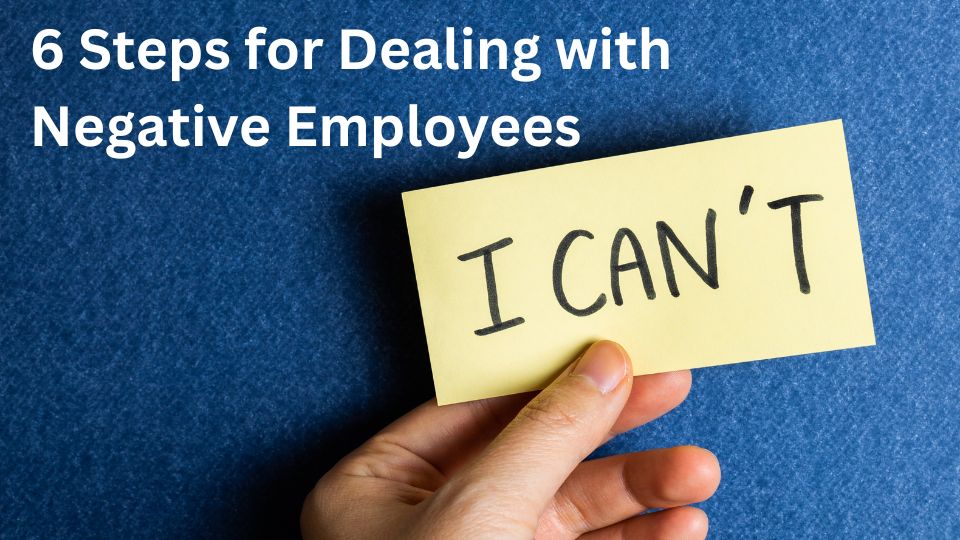6 Steps for Dealing with Negative Employees

Dealing with negative employees quickly is important to stop negativity spreading. Managing a negative team member can be difficult, managing a negative team is disastrous.
Not all negativity is bad. Some employees are by nature, glass half empty people, and they look for what can go wrong in every situation. These traits can be really useful if harnessed in the right way.
Other negative employees undermine their colleagues, spread negative rumours behind backs, pass blame onto others for their mistakes, and are constantly moaning about something. Dealing with negative team members who behave in this way quickly and fairly is a must.
Managing negative employees in the workplace doesn’t have to be difficult or have a bad outcome. Take these steps and be confident in getting to a sensible outcome for all concerned.
6 Steps for Dealing with Negative Employees:
- Don’t Ignore the Problem
- Gather Examples and Evidence
- Find Out Why
- Set Out Your Expectations
- Give Them a Chance to Change
- Take Formal Action
Watch on YouTube
Listen on Podcast
Don’t Ignore the Problem – the important first action when dealing with negative employees
Chances are the problem of negative employees will only grow if you don’t take action. There are lots of reasons an employee might be negative.
For instance, if a normally happy employee is being negative, they may:
- Have problems in the personal life
- Have a problem with an action or decision you or others within the business have taken
- Be having problems with colleagues on a personal level
- Be struggling with workload or a specific project and have become negative as a cry for help
There are loads of possible reasons.
Or, the team member might be naturally negative – always looking out for the problems in a situation and focused on the risks that might occur. This mindset can be very useful if engaged in a constructive way and if they manage their negativity appropriately.
Or they might be a destructive, negative employee, continually putting others down, making excuses for poor work, and generally being problematic.
Whatever the type of negative employee you have, don’t ignore the problem. If you do:
- Negativity may spread throughout the team
- You are in effect giving the negative employee permission to continue their behaviour through lack of action
- The negative behaviour may get worse
- Other team members may become demotivated or even leave the team and company because of the negative behaviour
- You might lose sales as negative employees make for unhappy customers
- If team motivation drops, then team performance will soon follow
None of this is good for you, nor the team and their performance, nor the business.
As manager, it is your job to manage negative team members so the team overall and individual team members are not impacted in a negative way.
You as manager, must take action to achieve this.
The second step when dealing with negative employees is to Gather Examples and Evidence
Gathering examples is a really important step. Evidence and fact trump opinion in most discussions. Using examples of what was said and what happened takes the emotional heat out of the discussion and are much harder to argue against. Examples help move the conversation away from one person’s opinion against the other person’s opinion.
Gather your examples and for each one, think through how you are going to explain the impact of what they said or did.
Talk about feelings, motivation, damaging relationships, weakening the team, and over time reducing team performance. All these things leave everyone involved worse off. If there is no impact, then there is no need to change so make the impact clear.
Make sure you have clear examples, and you can explain the impact on individuals, the team and the business before speaking to the negative employee.
Find Out Why – the third step when dealing with negative employees
There are so many reasons why there are negative employees in the workplace. There may be a specific reason as the result of an action, decision, or lack of action taken. Or the team member may be inherently negative as part of their personality.
Find out the nitty gritty of what is going on before deciding what action to take.
Book a private one-on-one meeting with the individual and outline your concerns. Take them through the examples you have put together and the impact you think their negativity is having . Be sympathetic and considerate of their feelings without watering down your message.
Ask them what they are thinking and feeling. Ask them what is causing them to feel and be negative. Then stop talking and listen to what they say.
Employ all your active listening skills. Take note of their tone of voice, their body language and all the other non-verbal clues they will be giving off while they speak.
If the team member is being negative because of an action taken or decision made by you, or elsewhere in the company, then you will have to take some corrective action to reduce or remove the negativity.
Actively listening to their concerns, being sympathetic and explaining the decision or action in more detail and giving them a chance to vent their annoyance, frustration, disappointment etc can work wonders in itself. When something is unfair, then do your best to rectify it. Your actions – whether successful or not – are often enough to remove the negativity.
If the reason for the employee being negative does not originate from you or the company, then move on to the next step.
The fourth step when dealing with negative employees: Set out your expectations
As manager or leader of a team, you set the rules. What you say and most importantly, what you do will tell the team what you expect from them.
When dealing with negative employees, explain to them the behaviour and actions you expect from them. Your expectations will be specific to your situation. Be clear about what you want and communicate this clearly.
I nearly always follow up with an email setting out my expectations in these situations. This provides a reference point for both parties and reduces confusion or misunderstandings. This reference point is useful later if their negativity doesn’t change.
Here are some of the expectations that I have set out in different situations to give you some ideas:
- Bring at least one solution with the problem
- Don’t say anything behind a person’s back that you wouldn’t say to their face
- Don’t moan generally – make it specific and constructive – we might be able to take action this way
- Be as realistic as possible – don’t under or over promise or big up or downplay situations
- You will not be aggressive or try to intimidate your work colleagues. If this continues I will have to take formal action.
- For every point you bring up that is not going well, bring up a point of what is going well
- I am very sympathetic to your personal situation. At the same time I have the whole team to look after. I am very happy to give you paid leave for you to seek counselling and support from experts who can really help you. What do you say?
Generally speaking, the more consistent you are with both what you say and what you do, the clearer the expectations you set with the team and the less trouble you will have from team members falling below those expectations.
Communicate your expectations clearly and consistently.
Give Them a Chance to Change – the fifth step when dealing with negative employees
In my experience it is well worth giving second changes for most situations. 9 times out of 10, the team member will respond positively, and you and the team will be better off.
So after you have understood the issue, and thought about what your expectations are and why, and you have told the employee and followed up in writing, give them a chance to change.
Put in the effort to help them change. Book in one-on-one meetings to mentor and provide coaching for them. This approach shows you care and are willing to help. This makes a big difference in itself.
For a glass half empty person, you might to coach them over a few months to be more balanced in how they feed back in team meetings for instance.
At the other end of the scale – for unacceptable behaviour for instance, you might expect the change to be immediate.
Match the timeframe – and how you support them – to the situation. Give them a realistic chance to change.
Take Formal Action – the final step when dealing with negative employees
By discussing the negative behaviour and setting your expectations you are asking the negative employee to change. For most employees this is more than enough.
Some employees will choose not to change for whatever reason or not take action to help themselves. At this point, weigh up the pros and cons of having this employee on your team and weigh up the impact of not taking further action on the rest of the team and your credibility as a manager.
Assuming you choose to take further action, then I would recommend starting with a Performance Improvement Plan. This is a more formal process setting out your expectations and what you are asking from the negative employee. You may want to consult with your HR team at this point.
Document the actions you are expecting them to take and what success looks like. Decide on timeframes – I would recommend a maximum of 3 months. Share this document with the negative employee and get their input and agreement with the goals. Coach and support them to improve and meet your expectations. This removes any excuses they might have about not getting support to improve.
Regularly review their progress.
If their negative behaviour does not improve to meet the expectations set out, then move the process into a disciplinary process, which may lead to the employee leaving. Follow your company policies and your legal requirements and work with your HR department through the process.
Good luck.
In summary
Managing a negative staff member can be frustrating and draining and is likely to be damaging to team morale. Take action to deal with negative employees so that their negative impact on the team is minimised or removed.
If you don’t take action in managing negative team members, by your lack of actions you communicating their behaviour is okay. This will not help anyone. Take action quickly.
The steps we have gone through are:
- Don’t Ignore the Problem
- Gather Examples and Evidence
- Find Out Why
- Set Out Your Expectations
- Give Them a Chance to Change
- Take Formal Action
I learnt quickly that dealing with negative employees fairly and quickly is a must to maintain good team motivation and happiness. Address the causes of negativity quickly.
If you’ve found this article useful please share it with friends and colleagues.






